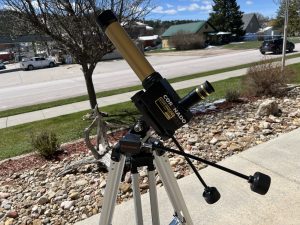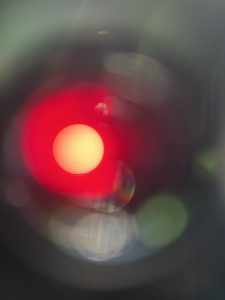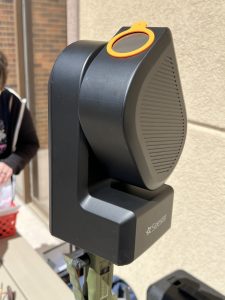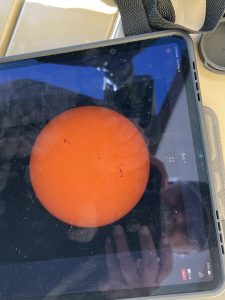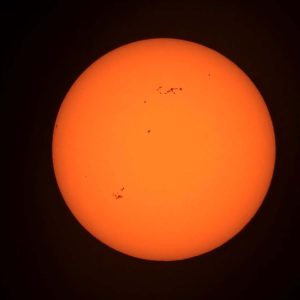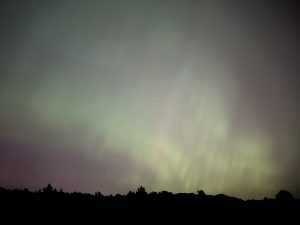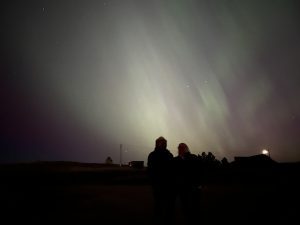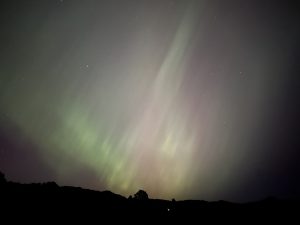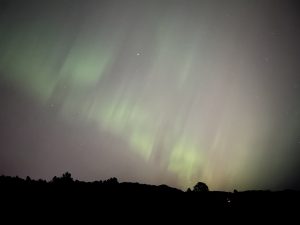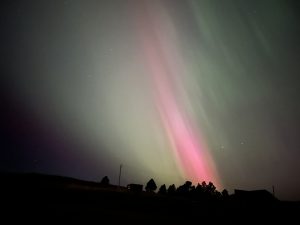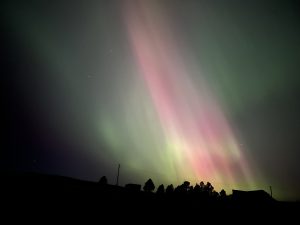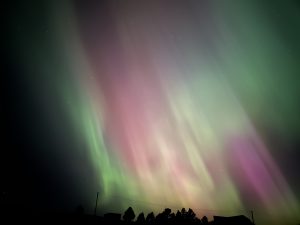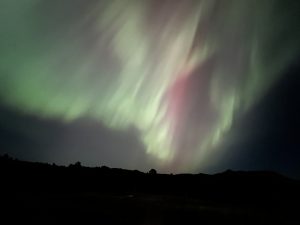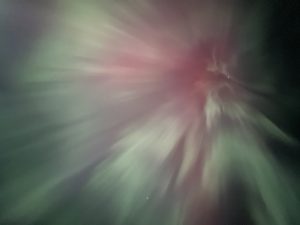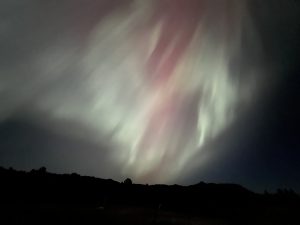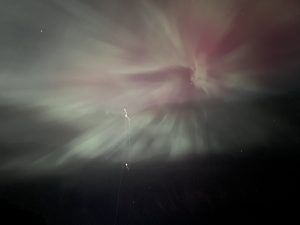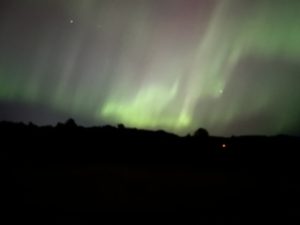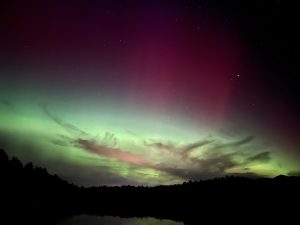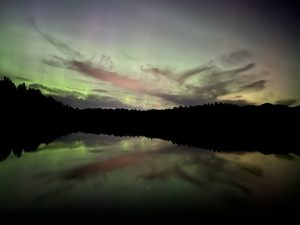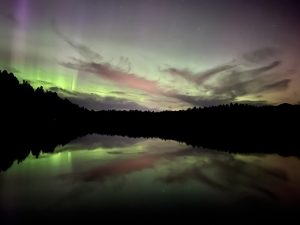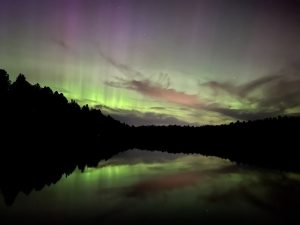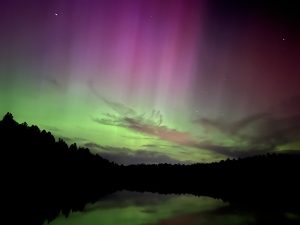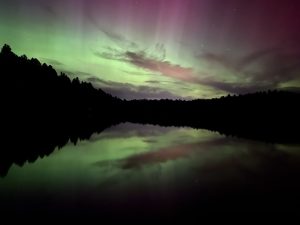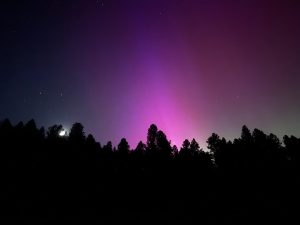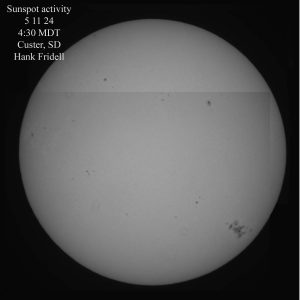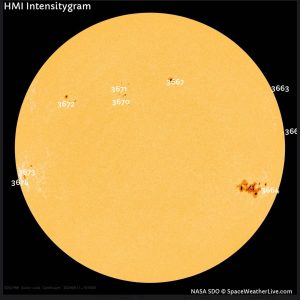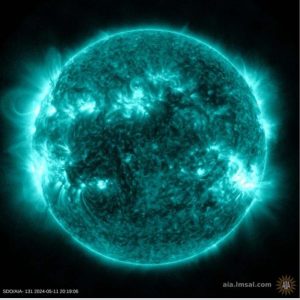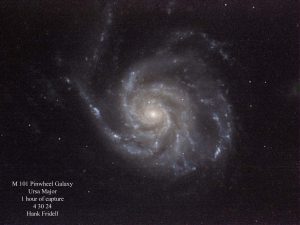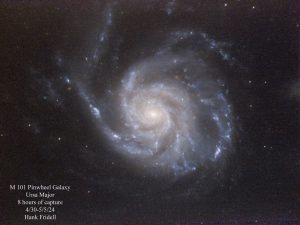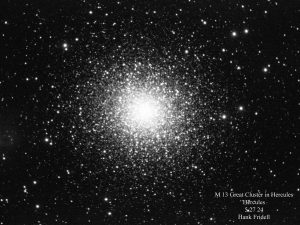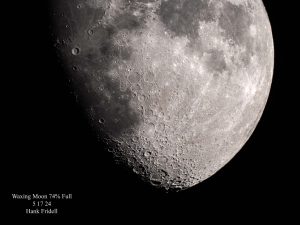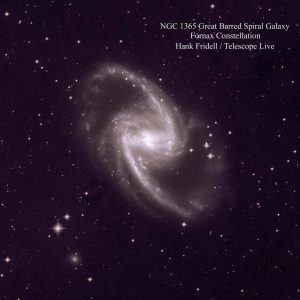Welcome to Hank’s May 2024 Astrophotography Blog! The night skies have been a mixed bag of stormy to startling, so let’s get into it. The month started out on May 4 with our local Custer Library sponsoring a May the Fourth Be With You Day, where they invited my astro-buddy Jim and me to help our library patrons look at the Sun. We were using protective eye gear and looking through a couple of different solar viewers: solar binoculars, solar telescopes and telescopes with solar filters. Very Cool! I brought the same telescope I used in April for the Total Solar Eclipse and the Library was able to round up a Coronado Solar Telescope that looks like this:
The image was taken with my iPhone looking down the Coronado eyepiece barrel, and to tell you the truth, I was not that impressed. For me the ZWO SeeStar telescope that Jim brought was the standout! The telescope costs $500, and once he set it on the ground, it was controlled by Jim’s iPad. The telescope was able to easily find the Sun on its own, focus it, take photos of the Sun and save those to his iPad! Check out these images of the SeeStar, Jim’s iPad with a solar photo on it, and the image it saved to his iPad. Very cool! Seestar is also powerful enough to capture some deep sky objects, the Moon, and Planets. If you are thinking you’d like to have a small telescope to do some viewing, but don’t want to be overwhelmed by it, this might be worth checking out. When’s my birthday?????
The big news of the month was the two nights the Aurora Borealis visited our southern Black Hills. On the 10th we set up near the Michelson Trailhead by Crazy Horse. It seemed to start slow off to the east, then showed up in the west, and finally the two sides joined together and just rolled over us. It was quite a thrill.
The following night, we went down to Stockade Lake, just a few miles east of us, and waited on the fishing dock, to catch the reflection of the Northern Lights in the lake. Another great night for us. On both nights I captured these images with my iPhone 13.
I use an app on my iphone to track solar activity called Space Weather Live. It shows the Kp Index forecast, which is the measure of global geomagnetic activity—and the chance of you seeing the northern lights. When the Kp Index gets up to about 6-9, there’s a chance it might show up in South Dakota, so I keep my eye on it. It also shows images of the current solar activity on the sun, like sunspots and solar flares. Lots of graphs and data there. It also shows you the current phase of the moon. Free! On the 11th I knew we were headed into a solar storm so I took a photo of the Sun during the day and compared it to the Space Weather Live images. The first photo is from my Celestron 8” SCT telescope with a solar filter showing the sunspots, the second shows a NASA image of the same, and the last shows the Sun’s solar flares.
For those of you who have been following my astro journey, you know I’ve been experimenting with longer exposure astrophotography. This month our Black Hills Astronomical Society (BHAS) asked its members to each take eight hours of images of M101, the Pinwheel Galaxy. It’s a beauty in Ursa Major, and last year showed a supernova in one of its arms (See my May 2023 blog for a photo of the Supernova). I took an hour’s worth of 2-minute exposures over the course of several nights and was able to get my eight hours captured! In astrophotography we are dealing with extremely small amounts of light, so to increase the resolution and detail in our photographs, we need to collect light for hours, not microseconds like with our iPhones. Think about it–this galaxy is 20.9 Million Light Years away! That is not only how far away it is, but also how long those photons have been traveling to hit my 1-inch square camera sensor. The image shown in my May 2023 photo was an exposure of about 15 minutes. Below shows what an hour of light and then what 8 hours of light shows. More time does make a difference. BHAS is hoping to collect at least 80 hours of light from our members for our joint project, and I’m excited to see what that result looks like! I’ll be posting it here as soon as we get all those hours processed.
To wrap things up, here are a couple of images I’ve been working with. First up is M13, a very large globular cluster, taken with my 8” Celestron (30 two-minute exposures). Next is a photo of our waxing Moon at about 74% full. The last is one of an image I acquired from Telescope Live, showing NGC 1365, a Great Barred Spiral Galaxy in the constellation Fornax, that is visible in the southern hemisphere. Telescope Live takes the exposures, and I get to process them. It was cheaper than flying to Australia; plus, they have better telescopes than I do.
Until next month, Clear Skies. -Hank




